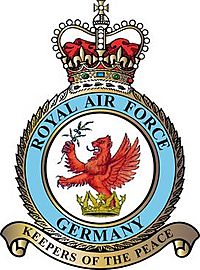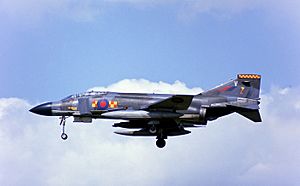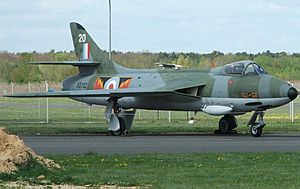Royal Air Force Germany facts for kids
Quick facts for kids Royal Air Force Germany |
|
|---|---|

Royal Air Force Germany badge
|
|
| Active | 1 January 1959–1 April 1993 |
| Country | Germany |
| Allegiance | |
| Branch | |
| Type | Royal Air Force command |
| Part of | British Armed Forces, UK Ministry of Defence |
| Headquarters | RAF Rheindahlen |
| Nickname(s) | RAFG |
| Motto(s) | Keepers of the Peace |
| March | Royal Air Force March Past |
Royal Air Force Germany, often called RAF Germany or RAFG, was a special part of the Royal Air Force (RAF). It was made up of RAF units based in Germany. At first, these units were in West Germany after the Second World War. Later, they helped defend Europe during the Cold War. The person in charge of RAF Germany also led NATO's Second Allied Tactical Air Force. Its motto was 'Keepers of the Peace'.
Contents
History of RAF Germany

RAF Germany started on January 1, 1959. It was a new name for the RAF's Second Tactical Air Force. Its main base stayed at RAF Rheindahlen. The commander, Air Marshal Sir John Edwardes-Jones, continued in his role.
At first, RAF Germany flew planes from six airfields. Four of these, Geilenkirchen, Laarbruch, Bruggen, and Wildenrath, were newer airfields. The other two, Jever and Gutersloh, had been used since the end of World War II. The aircraft used included the English Electric Canberra bomber, the Hawker Hunter fighter-bomber, and the Supermarine Swift for reconnaissance (looking at things from the air).
In 1961, RAF Germany had one less airfield when Jever was given back to West Germany. Geilenkirchen followed in 1968. This meant operations focused on four main RAF stations. During this time, RAFG also got special interceptor planes. These were English Electric Lightnings from 19 and 92 Squadrons, which came from the United Kingdom.
New Aircraft and Reorganization
From 1969, RAFG started getting newer aircraft. This was important because it was on the front line of the Cold War. The command also changed how it was set up, so that each airbase mainly used one type of aircraft.
- Laarbruch became home to the Blackburn Buccaneer strike aircraft. These were flown by XV and 16 Squadrons.
- Bruggen received the McDonnell Douglas Phantom fighter-bombers. These were flown by 14, 17, and 31 Squadrons.
- Wildenrath got the Hawker Siddeley Harrier planes. These were flown by 3, 4, and 20 Squadrons.
- Gutersloh was home to the two Lightning squadrons. In 1970, Westland Wessex helicopters from 18 Squadron joined them.
- 25 Squadron protected the three main bases with Bloodhound SAM missiles.
An exception was II Squadron, which flew their Phantoms for reconnaissance from Laarbruch. At this time, a communications flight became 60 Squadron. The commander of RAF Germany was Air Marshal Harold 'Mick' Martin, famous for the Dambuster raid.
More changes happened in 1975 with the arrival of the SEPECAT Jaguar. The three squadrons at Bruggen switched to this new strike and ground attack aircraft. Later, 20 Squadron also moved to Bruggen with Jaguars. II Squadron also got Jaguars but stayed at Laarbruch for reconnaissance.
In 1977, Wildenrath and Gutersloh swapped roles. 19 and 92 Squadrons switched to the Phantom for air defence and moved to Wildenrath. 3 and 4 Squadrons with their Harriers moved to Gutersloh. 230 Squadron and their Westland Puma helicopters arrived at Gutersloh in 1980. They replaced 18 Squadron, which was getting ready for new Boeing Chinook helicopters. After getting their new Chinooks and serving in the Falklands War, 18 Squadron returned in 1983. Both helicopter units supported the British Army of the Rhine (BAOR).
The Tornado Era and End of the Cold War
In 1983, the Panavia Tornado multi-role aircraft arrived in RAF Germany. It first entered service with XV Squadron. The Tornado was meant to equip the three units at Laarbruch, but it eventually replaced the Jaguar across all of RAFG. This included 20 Squadron moving to Laarbruch.
In 1986, IX Squadron arrived at Bruggen. Also, RAFG stopped its nuclear Quick Response Alert duty, which it had done since it began. The Jaguar aircraft finally left RAF Germany in 1988. II Squadron replaced their Jaguars with Tornados that had a special reconnaissance system. The next year, 3 and 4 Squadrons started replacing their older Harrier GR3 and GR5s with the newer Harrier II. 25 Squadron was disbanded in October, ending nearly twenty years of Bloodhound SAM missile operations in Germany.
The fall of the Berlin Wall and the end of the Warsaw Pact led to big changes for British defense. RAF Germany was also affected. A plan called "Options for Change" announced that the command would shrink. Wildenrath was to close, and its Phantom squadrons would be disbanded. Gutersloh would be given to the British Army, and its squadrons would move to Laarbruch. In turn, Laarbruch would have three of its Tornado squadrons disbanded.
Gulf War and Disbandment
These plans were quickly changed by events in the Gulf, after the Iraqi invasion of Kuwait. RAF Germany sent most of its Tornado force to the region. Squadrons XV, 16, and 31 provided the main aircraft and personnel. Sadly, three aircrew members, Squadron Leaders Garry Lennox and Kevin Weeks from 16 Squadron, and Flight Lieutenant Steve Hicks from XV Squadron, were killed in action. They were among over one hundred aircrew lost while serving with RAFG units.
Even after their successful service in the Gulf, the "Options for Change" plans went ahead. 92 Squadron at Wildenrath was the first to disband in July 1991. 19 Squadron followed in January 1992, and the Wildenrath station itself closed that April. At Laarbruch, both XV and 16 Squadrons were disbanded in 1991, and II Squadron moved to RAF Marham. 20 Squadron stayed but disbanded in July 1992. Later that year, 3, 4, and 18 Squadrons moved from Gutersloh. 230 Squadron had already moved to RAF Aldergrove in Northern Ireland that April.
RAF Germany officially ended on April 1, 1993. It was disbanded and renamed No.2 Group of Strike Command. Air Marshal Sandy Wilson was its last commander. 2 Group itself was later combined into 1 Group in 1996. The last British forces left Germany in 2002, after the closures of Laarbruch and Bruggen.
RAF Germany's Structure and Flying Units in 1989
In 1989, RAF Germany was based at RAF Rheindahlen. Its commander also led NATO's Second Allied Tactical Air Force. Here's a look at some of its main parts:
- Royal Air Force Germany Headquarters at RAF Rheindahlen
- 4 Wing: This managed the RAF Regiment Rapier missile squadrons in West Germany.
- 33 Wing: This managed the RAF Regiment Light Armour squadrons in West Germany.
- RAF Bruggen, West Germany
- No. 9 Squadron: Flew 12 Tornado GR1 aircraft for important defense missions.
- No. 14 Squadron: Flew 12 Tornado GR1 aircraft for important defense missions.
- No. 17 Squadron: Flew 12 Tornado GR1 aircraft for important defense missions.
- No. 31 Squadron: Flew 12 Tornado GR1 aircraft for important defense missions.
- No. 37 Squadron RAF Regiment: Provided air defense with 8 Rapier missile launchers.
- No. 51 Squadron RAF Regiment: Used light armored vehicles like 15 Spartan and 6 Scorpion.
- RAF Gütersloh, West Germany
- No. 3 Squadron: Flew 16 Harrier GR5 aircraft.
- No. 4 Squadron: Flew 16 Harrier GR5 aircraft.
- No. 18 Squadron: Flew 16 CH-47 Chinook helicopters, supporting the British Army of the Rhine.
- No. 230 Squadron: Flew 16 Puma HC1 helicopters, supporting the British Army of the Rhine.
- No. 63 Squadron RAF Regiment: Provided air defense with 8 Rapier missile launchers.
- RAF Laarbruch, West Germany
- No. 2 Squadron: Flew 12 Tornado GR1A aircraft for aerial reconnaissance.
- No. 15 Squadron: Flew 12 Tornado GR1 aircraft for important defense missions.
- No. 16 Squadron: Flew 12 Tornado GR1 aircraft for important defense missions.
- No. 20 Squadron: Flew 12 Tornado GR1 aircraft for important defense missions.
- No. 1 Squadron RAF Regiment: Used light armored vehicles like 15 Spartan and 6 Scorpion.
- No. 26 Squadron RAF Regiment: Provided air defense with 8 Rapier missile launchers.
- RAF Wildenrath, West Germany
- No. 19 Squadron: Flew 16 Phantom FGR2 aircraft.
- No. 92 Squadron: Flew 16 Phantom FGR2 aircraft.
- No. 60 Squadron: Flew Andover CC2 transport planes.
- No. 16 Squadron RAF Regiment: Provided air defense with 8 Rapier missile launchers.
RAF Germany Stations and Establishments
| RAF station | location | dates active | notes / current use |
|---|---|---|---|
| RAF Ahlhorn | Ahlhorn, Lower Saxony | 1945 – 1958 | Originally an airfield for German Zeppelins. |
| RAF Bad Kohlgrub | Bad Kohlgrub, Bavaria | 1950s- | Site of RAF Germany Winter Survival School. |
| RAF Bruggen | Elmpt, North Rhine-Westphalia | 1958 - 2002 | After the RAF left, British Army units moved here. |
| RAF Bückeburg | 1946 - 1960 | Now Bückeburg Air Base. | |
| RAF Butzweilerhof | Cologne | August 1951 - January 31, 1967 | Now a residential and shopping area. |
| RAF Celle | Celle | April 11, 1945 – November 29, 1957 | Handed over to the Bundeswehr (German armed forces). |
| RAF Fassberg | Fassberg, Lower Saxony | April 1945 - January 1, 1957 | Handed over to the Bundeswehr. |
| RAF Fuhlsbüttel | Fuhlsbüttel | Now Hamburg Airport. | |
| RAF Gatow | Berlin | August 19, 1945 – September 7, 1994 | Now a military museum and barracks. |
| RAF Geilenkirchen | Geilenkirchen | May 1953 - March 1968 | Handed over to the Bundeswehr, now NATO Air Base Geilenkirchen. |
| RAF Gütersloh | Gütersloh | June 27, 1945 – 1993 | After the RAF left, British Army units moved here. |
| RAF Hambühren | Hambühren | A communications site. | |
| RAF Hehn | Hehn | Main communications center for RAFG and BAOR. | |
| RAF Hustedt | Hustedt | An airfield. | |
| RAF Husum | Husum, Schleswig-Holstein | A remote radar station near Husum. | |
| RAF Jever | Jever | April 1945 - 1961 | Handed over to the Bundeswehr. |
| RAF Laarbruch | Weeze | March 1945 - 1999 | Now Weeze Airport. |
| RAF Lübeck | Lübeck | 1945 - 1997 | Also known as RAF Blankensee, now Lübeck Airport. |
| RAF Lüneburg | Lüneburg | Now Lüneburg Airfield. | |
| RAF Nordhorn | Nordhorn | 1945 - March 2001 | An air weapons range. |
| RAF Nörvenich | Nörvenich | ???? - mid-1950s | Handed over to the Bundeswehr. |
| RAF Oldenburg | Oldenburg | ???? - October 1957 | Handed over to the Bundeswehr, now used by the German Air Force. |
| RAF Plantlünne | Plantlünne | April 9, 1945 - May 1945 | An airfield. |
| RAF Rheindahlen | Rheindahlen | October 1945 - December 2013 | Former RAFG headquarters, now British Forces Germany headquarters. |
| RAF Schleswigland | Schleswigland | 1945 - October 1959 | Handed over to the Bundeswehr. |
| RAF Sundern | Sundern | ???? - 1961 | A non-flying base; British Army units moved here later. |
| RAF Sylt | Sylt | 1945 - October 16, 1961 | Now Sylt Airport. |
| RAF Uetersen | Uetersen | ???? - November 1955 | RAF presence until late 1955. |
| RAF Wahn | Bonn | Now Cologne Bonn Airport. | |
| RAF Hospital Wegberg | Wegberg | 1953 - April 1, 1996 | Headquarters for British Forces Germany Health Service, now demolished. |
| RAF Wildenrath | Wildenrath | January 15, 1952 – April 1, 1992 | Now mainly a railway testing center. |
| RAF Winterberg | Winterberg | A former radio navigation unit. | |
| RAF Wunstorf | Wunstorf | April 7, 1945 - 1957 | Handed over to the Bundeswehr. |
See also
- List of Royal Air Force commands
- Royal Air Force station
- List of Royal Air Force stations
- List of former Royal Air Force stations
- RAF Regiment
- List of RAF Regiment units
- Military of Germany (disambiguation)
- Wehrmacht
- National People's Army
- German Air Force


